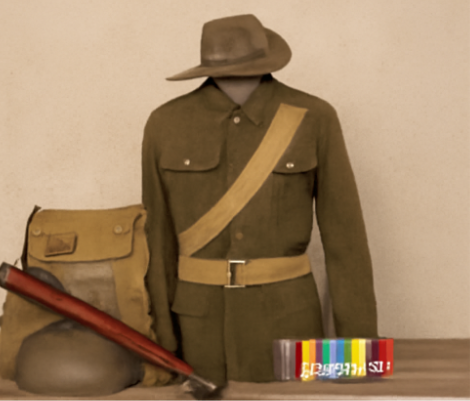
WW1 British Uniforms for Sale: Buy, Collect, and Learn the History Behind the Fabric
Published on Sep 22, 2025
Introduction: Would You Spend $2,000 on a Piece of Wool?
Did you know that some original WW1 British officer uniforms can sell for over $2,000 today? That’s right—something once mass-produced for war is now a prized collector's item.
Whether you're into historical reenactments, costume design, military memorabilia, or love British history, WW1 British uniforms are a fascinating world to explore. But how do you know what to look for? What were these uniforms made of? And where can you buy authentic or replica WW1 British uniforms?
Let’s break it all down.
What Were British Military Uniforms Made of in WW1?
Materials That Withstood the Trenches
The British Army in WW1 needed uniforms that could endure the mud, blood, and horror of trench warfare. Here's what they were made from:
- Wool Serge: The most common material. Warm, durable, and somewhat water-resistant.
- Cotton: Used for shirts, undergarments, and summer gear.
- Leather: For belts, boots, and some equipment like holsters.
- Canvas Webbing: For load-carrying gear like the 1908 Pattern Web Equipment.
Key Takeaway:
Wool was king. If you're buying or evaluating a WW1 British uniform, look for heavy wool serge fabric—that's your biggest authenticity marker.
Types of WW1 British Uniforms: Officer vs Infantry
There was a major difference between what officers and common soldiers wore.
British Infantry Uniforms (Enlisted Men):
- Service Dress Tunic: High collar, large chest pockets.
- Trousers (aka WW2 trousers in modern surplus listings): Straight-cut, wool serge.
- Puttees: Long woolen wraps worn around the lower legs.
- Cap: Soft peaked cap, khaki wool.
British Officer Uniforms:
- Tailored from finer materials.
- Usually custom-made (hence why original officer uniforms are more valuable).
- More variation in color and cut—some had riding breeches or leather boots.
- Included insignia, rank pips, and Sam Browne belt.
Where to Find WW1 British Uniforms for Sale
Authentic vs Reproduction: Know the Difference
There are two main types of WW1 British uniforms for sale:
- Authentic: Worn during WW1, often very expensive and fragile.
- Reproduction: Made to look like originals, used for reenactment, theater, or film.
Top Sources for Purchase:
1. Online Auction Sites
- eBay: Search for "WW1 British officer uniform" or "WW1 British uniforms for sale."
- Caveat: Watch out for fakes or misleading descriptions.
2. Military Collectible Shops
- Websites like MilitaryTour.com, Soldier of Fortune, and Epic Militaria.
- These often offer both reproduction and genuine surplus items.
3. Reenactment Communities
- Forums and Facebook groups often have buy/sell boards.
- Reputable reenactors will know what’s legit.
4. Antique and Military Shows
- Great for hands-on inspection.
- Often includes vendors with deep historical knowledge.
How to Spot a Quality WW1 British Uniform (Buying Guide)
Whether you're looking for an authentic piece or a reproduction, here are things to check:
For Authentic Uniforms:
- Look for manufacturer stamps, typically inside the tunic.
- War Department Broad Arrow mark (↑) is a legit identifier.
- Wool should be coarse, heavy, and olive-drab colored.
- Expect wear and fading—a good sign of age.
For Reproduction Uniforms:
- Compare fabric to period photos.
- Check stitching and buttons—authentic reproductions will mimic original styles.
- Ask the seller what pattern the uniform follows (e.g., 1902 Service Dress).
How WW2 Trousers Fit Into This
You’ll often see WW2 trousers listed in WW1 uniform sets. Why?
- Similarity: Early WW2 British uniforms were nearly identical to WW1 ones.
- Surplus: WW2 gear is more widely available and cheaper.
- Compatibility: Acceptable for many reenactments.
Pro Tip:
If you're just getting started in reenactment or cosplay, using WW2 trousers with a WW1 tunic is totally fine—especially if you're on a budget.
WW1 British Uniform Accessories: Complete the Look
To fully kit out your uniform, you’ll want:
- 1908 Pattern Webbing: For ammo pouches and water bottles.
- Puttees or Gaiters: Wraps around the calves.
- Brodie Helmet: That iconic steel hat.
- Greatcoat: Long wool coat for cold weather.
- Boots: Hobnail boots or reproduction trench boots.
Real-Life Example: How a Collector Built His Uniform for Under $500
Let’s say you're starting from scratch and want a decent reproduction WW1 British infantry uniform.
Budget Breakdown:
- Repro Service Dress Tunic: $120
- Wool Trousers (WW2 style): $60
- Webbing Set: $100
- Repro Boots: $80
- Helmet (Repro): $70
- Accessories (Cap, Patches, etc.): $50
Total: $480
That’s a complete WW1 British soldier look—perfect for reenactment or historical education events.
Maintenance & Storage Tips
If you buy an original uniform:
- Store in a cool, dry place.
- Avoid sunlight — it fades and weakens wool.
- Use acid-free tissue if you’re folding it.
- Do NOT dry clean — consult a textile preservation expert.
Why People Buy These Uniforms: More Than Just Fabric
- Reenactors: Bringing history to life at events and schools.
- Collectors: Owning a piece of history.
- Cosplayers: Using for film or photography projects.
- Educators: Museum displays and teaching tools.
- Historians: Studying the construction and evolution of military gear.
Conclusion: Start Your Uniform Journey Today
WW1 British uniforms aren’t just clothing—they’re living artifacts. Whether you want to wear one, display it, or study it, knowing what to look for and where to buy is half the battle.
Ready to find your perfect WW1 British uniform?
Start browsing trusted sellers, connect with reenactor groups, or explore military surplus shops. Even one piece—like a tunic or cap—can kickstart a powerful connection to history.
